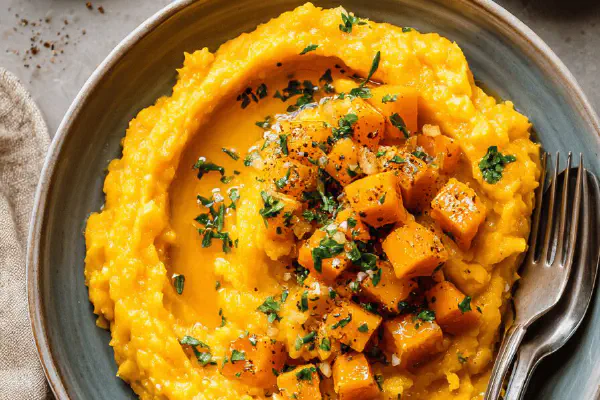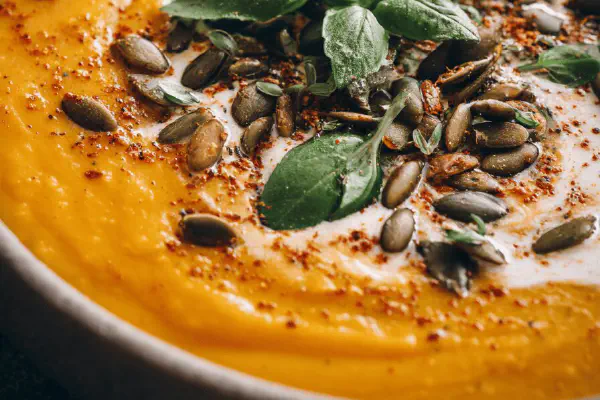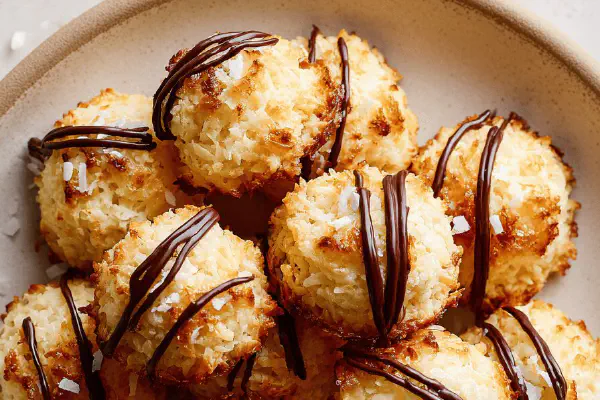Butternut Squash Purée Twist

E
By Emma
Certified Culinary Professional
•
Recipe tested & approved
Cubed butternut softened with shallots and roasted garlic in olive oil. Simmered in vegetable broth until tender. Blended with a touch of coconut milk for creaminess and a hint of ginger for warmth. Salt and white pepper to taste. A veggie side or starter that shifts easily. No nuts, dairy, gluten, or eggs here. Roughly 25 minutes active cooking and 20 minutes simmering. Yields 4 servings.
Prep:
25 min
Cook:
20 min
Total:
45 min
Servings:
4 servings
#vegan
#comfort food
#squash recipes
#gluten-free
#dairy-free
#easy sides
#french-inspired
Steam rising, edges caramelizing on cubes of butternut — that smell, like fall caught in a pot. No rush. Shallots sweat slowly in olive oil releasing that gentle sweetness, mixing with mellow roasted garlic, the kind you make ahead while juggling other dishes. You want to see those colors deepen, smells turning richer before the broth hits and the real cooking begins. Gentle simmer, barely a whisper of bubble, tells you when squash is ready — not squishy, just tender enough to mash with a fork but not fall apart. Blending with coconut milk and ginger spices it up, turns it creamy without dairy. This part took trial and error — the difference between greasy and velvety. Now it’s about texture, balance, knowing when salt says enough or when pepper surprises. Play with heat, taste like you mean it. Nothing allowed to scorch or turn bitter. Butternut done right is subtle but vivid — a weirdly satisfying comfort.
Ingredients
- 1 large shallot, finely chopped
- 3 cloves roasted garlic, mashed
- 3 tbsp olive oil
- 1.1 litre (4 1/2 cups) butternut squash, peeled and cubed
- 300 ml (1 1/4 cup) vegetable broth
- 100 ml (1/2 cup) canned coconut milk
- 1 tsp grated fresh ginger
- Salt and white pepper to taste
About the ingredients
Swapped onion for shallot for subtlety and gentler sweetness. Garlic goes roasted — less harsh, more caramel notes, easier to control so it doesn’t dominate. Olive oil replaces butter for a cleaner, lighter fat, and keeps it vegan and lactose-free. Coconut milk adds creaminess without dairy, plus a touch of natural sweetness and fat that carries the ginger flavor. Used vegetable broth to keep it vegetarian and provide a more neutral base that highlights the butternut’s flavor. Fresh ginger is a wildcard — adds gentle heat and brightness but can clash if overdone, so handle with care. White pepper for a milder peppery note, avoids black pepper’s sharp bite. Good quality, fresh ingredients matter here — avoid too old garlic or splotchy squash. Peeling squash isn’t fun but necessary — use a sharp peeler for even, thin slices to avoid waste.
Method
- Heat olive oil in a heavy saucepan over medium heat. Toss in shallots, sweat them slowly until translucent and soft but not browned. This slow softening makes all the difference – sharp bits kill the sweetness.
- Add the mashed roasted garlic. Stir just until it smells fragrant—don’t let it scorch; bitter garlic ruins the base.
- Dump in cubed butternut. Toss gently. Let it sizzle for about 7 minutes, stirring occasionally. Look for edges starting to caramelize. Those golden bits? Flavor gold.
- Splash in vegetable broth. Don’t cover it all at once; just enough to drown half the veggies. Butter or cream swap here usually, but broth keeps it lighter and sharper.
- Simmer uncovered at low to medium-low heat. Steam should rise, slight bubbling. About 25 minutes. Poke the largest cubes with a knife. Soft but not mushy – you’ll want a bit of texture, not baby food.
- When done, off the heat. Cool slightly so the blender doesn’t glue shut or splatter.
- Into the food processor with butternut mix, roasted garlic and shallots. Pour in coconut milk, add grated ginger, salt, white pepper.
- Pulse several times, then puree until smooth-ish. Not perfectly velvety; a little grain is good. Texture shows it’s handmade.
- Taste, adjust salt and pepper. Sometimes that ginger hits too hard; balance carefully.
- Keep covered warm. Reheat gently over low heat if needed. Add more coconut milk to loosen if it thickens too much. Avoid reheating directly at high heat, scorched squash is never pretty.
- Serve warm with crusty bread or as a velvety base for roasted meats or fish.
Cooking tips
Sweating shallots slowly is key — don’t rush to brown; that ruins the base flavor. Roasted garlic mashed before adding blends better and avoids uneven bitterness. Tossing squash at the right time gets those caramelized edges that amp up flavor complexity. Watch the pan closely — too high heat scorches. Simmering with broth gently poaches squash, flavor bleeding out without diluting. Peeling and poking cubes tests for readiness — visual cues over timers here. Off heat before blending prevents explosion and overprocessing. Pulse, don’t overblend — preserve some texture. Coconut milk added post-cooking for smoothness — adding during cooking risks separation. Ginger grated fresh, added last-minute avoids bitterness. Salt and white pepper adjusted after blending for control. Reheating slow; add coconut milk to loosen — too thick gives gluey feel. Pair with crusty bread or as a sauce base; leftovers freeze well. Keep a back-up broth or milk substitute for last-minute substitutions — almond milk is an ok swap but watch for off-flavors. Avoid using canned garlic — always fresh or roasted fresh.
Chef's notes
- 💡 Sweat shallots very slowly in olive oil. Watch color shift, translucent not browned. Sharp edges kill softness. That sweetness unlocks base flavor, no shortcuts.
- 💡 Roast garlic ahead. Mash it smooth before adding or risk uneven bitterness. Stir in gently, smell first for toasty warmth. Avoid burning at all costs.
- 💡 Cubed butternut needs toss and sizzle for 7 minutes minimum. Look for edges caramelizing like tiny amber waves. That caramel marks flavor depth, don’t stir too much.
- 💡 Adding broth gradually is key. Half-submerged cubes, not drowned. Keeps squash tender with texture, avoids dilution. Steam bubbles soft, not furious.
- 💡 Pulse then blend after cooling mix only slightly. Overprocessing turns glue; texture needed. Coconut milk goes last; adding during cooking splits mix, separates fat.
- 💡 Fresh ginger grated fine, added at the last second. Spice can dominate quick, best balanced post-blend so it heats but doesn’t burn or shriek.
- 💡 Slow reheating is vital. High heat scorches paste quickly. Add more coconut milk if thick or gummy. Keep it fluid but no water-downed mess here.
- 💡 Peeling squash? Use very sharp peeler. Thin slices avoid waste and bitterness from skin. Rough edges flop while cooking, avoid leftovers too tough to swallow.
Common questions
Why slow sweat shallots?
Fast browning kills sweet base. Sweat long; smells soften. That buttery softness underpins rest. No shortcuts, no burns.
Can I swap coconut milk?
Almond milk okay but watch flavor clash. Thinner, less fat, changes texture. Cream substitutes risky; broth alters mouthfeel. Try batches.
What if squash too mushy?
Poke cubes mid-simmer. Pulp feel means overcooked. Texture lost. Adjust simmer timer down, bigger cubes hold shape better. Try thickening after instead.
How to store leftovers?
Fridge covered tightly, 3-4 days max. Freeze in sealed containers, thaw gently. Reheat low to avoid scorch. Coconut milk may separate, stir back in.



